Sunday Summaries 13/03/2016
By Mento 0 Comments
It's another Sunday, which means it's time to do some summarizing. This week I've mostly been pondering negative criticism. Negative in tone, that is, not criticism of minimal informational value; there's an important distinction to be made there for another time.
These thoughts were spurred into being by Tearaway: Unfolded, which I'm finding that I dislike quite a bit. I'll expand on that more when I cover it at the end of this summary update, but it and I have fundamental differences when it comes to game design approach. Specifically, it ties in to two semi-recent screeds I wrote about what I consider paramount to game design - specifically, the importance of not dropping the ball for the completionist set and the importance of not wasting the player's time unnecessarily - both of which are axioms (well, in my eyes) that Tearaway and developers Media Molecule have opted to scorn.
At the same time, it's depressingly easy especially in the midst of frustration to throw shade at game developers. It's rather telling that I use words like "axiom" to describe my perspective on the matter, as if that is the only worthy take to consider. Tearaway is an endlessly inventive game that tries to include the player in some intriguing ways, as an extension to the slightly cutesy and creative approach they took to player agency with their LittleBigPlanet series. The developers clearly had a specific goal for Tearaway, and it frequently clashes with the game's status as a competent platformer in some more core "game design-y" respects. Had I less of a gameplay-focused mindset for game design, I could much better appreciate what the game is trying to do in connecting to its player. (And, spoilers for the below section, my predilection for collecting everything is also ruining the game significantly.)
What this all amounts to is a confession, or a resolution really: I need to get better at voicing my disappointment with a game without passive-aggressively deriding its developers as incompetents or imbeciles, explicitly or implicitly. There's a lot of obvious factors why it shouldn't be the reviewer's prerogative to use such invective or cling too tightly onto their own preconceptions of what constitutes good game design: maybe the developers placed their priorities elsewhere, or the project became more ambitious as it went on and was harder to manage, or that the many disparate contributions and ideas didn't quite coalesce in a way that everyone hoped. Plus, it's just the height of rudeness to imply that they can't do their jobs right. This is all obvious enough in the abstract, but it becomes easy to lose sight of this in the heat of frustration when it becomes a judgment as emotionally illogical as "this controller's busted" or "this milliseconds' worth of lag is killing me".
But man, does it ever feel great to vent on the internet. Look forward to that (I guess?) when I start talking about Tearaway again a little later on. For now, it's time to listen to some She and chill while writing about the less annoying things going on last week and the week to come.
New Games!
Really slim pickings in the middle of March, unless I'm missing something significant from the Indie sector. Wouldn't be the first time this year, if a certain Stardew Valley tearing up the charts for the past two weeks is anything to go by. Farming-aside, it seems the pick of the crop this week is Salt and Sanctuary; the newest monochrome 2D action game from Ska Studios. If I've learned anything from the increasing ubiquity of the "it's like Dark Souls" comparison, there's so many fundamental similarities between FromSoftware's smash series and modern game design that we're perhaps overlooking how much of it is an deliberate allusion or entirely incidental. However, in specific cases like Salt and Sanctuary and 2014's Lords of the Fallen, the Souls connection appears to be more than just skin-deep. Either way, I liked enough of what I saw of the game the few times Jason showed it off in UPFs past to add it to the ol' Steam wishlist. That list grows ever longer, even in spite of semi-regular pruning.
Other releases this week include:
- The US launch of Samurai Warriors 4: Empires, the semi-strategic spin-off of the most recent game in the Sengoku-set Musou games. I'm building lists for new genres and new themes we might consider adding after the big wiki update (coming any day now, I'm sure), and Sengoku is definitely close to the top for the latter. It feels like every other Super Famicom strategy game page I work on is about Oda Nobunaga or Takeda Shingen or Date Masamune (the other half of those games based on, naturally enough, the Three Kingdoms era of Ancient China, which is also on that list). As for the game itself, I don't have much truck with Musou games as a matter of rule: as a completionist, I got put off fairly quickly by the immense amount of samey content. Didn't seem conducive to spend a month playing through the Yellow Turban Rebellion (or Sengoku equivalent) with ever so slightly different characters.
- We also have the pneumatic kunoichis of Senran Kagura: Estival Versus (I'm so glad someone else is using the word "estival". It's a good one, especially for rhyming titles) in another PS4 localization out this week. I'm always impressed, in an odd and perhaps slightly condescending use of the term, when a game series can succeed largely through cheesecake and fan service. From reports, it doesn't seem the Senran Kagura games are all that great on a purely technical level (though there's me throwing shade again), and in this marvelous future where ribald virtual nudity is but a click away that a game franchise can crystallize and capitalize on side-boob and innuendo is sort of charming. Yeah, all right, maybe I overdid it with the condescension.
- Last and perhaps oddest is the Wii U version of Pokkén Tournament, the Pokémon fighting game. I'm getting a crash course in the new generations of Pokémon through Pokémon Picross, and learning they're all fairly interchangeable with nonsense names, but maybe a fighter game can help flesh out a handful for me. We can talk about indirect characterization in games and how the medium lets you connect to a character by simply being around them and watching how they carry themselves without beating you over the head by explicitly stating their motivations and feelings every five minutes, but I think a full and diverse moveset of a well-developed fighting character will often tell you a lot more about that character than some poorly drawn series of still images that seems to amount to a story mode these days. I still hold the inexplicable success of Lucario as a paragon of my issues with modern Pokémon: it doesn't look like anything besides possibly a jackal, its name isn't a pun nor does it jokingly refer to anything about the (non-)animal or object it's based on, and it's covered with the same weird WipeOut style future-bumps that Mewtwo sports just like every other new Pokémon. Maybe that's just me though. I'm sure modern Pokémon has as many quirky loveable oddballs and cute real animal surrogates as the original 151; they just aren't cool enough to make it to Smash Bros. and other crossovers where I might see them. Man, this got weirdly critical of Pokémon all of a sudden, huh?
Wiki!

Still trucking on with the Super Nintendo's 1995 library. Yo, spoilers: I'm going to be here for a long time. Maybe the rest of the year, in fact, though I'm pleased with my progress so far. I've already completed January - though, naturally, it was a fairly slow month - and am halfway through the far more populous February releases. It's weird: Februarys (Februaries?) are usually as barren as January, maybe even more so with that two-three day deficit, but the February of 1995 saw 41 new releases for the Super Nintendo and Super Famicom. That's the fourth busiest month of the year, after March, September and December. I suspect it has something to do with how the Super Nintendo was over the hill at this point in its lifespan and was starting its sudden decline: though 1995's 400+ releases is nothing to sneeze at, it's at least 70 less than the previous year and the next would have a paltry ~180 as the Sony PlayStation continued to bury the once-juggernaut and Nintendo focused more of its energies on the competing Nintendo 64. Having a stacked first half makes sense if you consider that many third-party developers were already beginning to drop off SNES development to focus on PlayStation, Sega Saturn and the N64 after the end of 1994, completing the projects they had before moving on.
I managed to get twenty games closer to my goal last week, five of which were brand new pages. If you didn't know already about it, I've been regularly updating a list that includes every Super Nintendo and Super Famicom game I've added to the wiki. Makes more sense to just link to that than repeat myself here. Instead, here's a few pages that were mostly empty before I got around to them and perhaps deserve more attention:
- Stardust Suplex isn't quite what it sounds like; rather than featuring the eccentric starchild who occasionally descends to Earth to Irish whip less fanciful wrestlers and perhaps give Giant Bomb a GOTY list every now and again, it's an all-women Joshi wrestling game that pulls a Fire Pro Wrestling and creates a stable of fictional wrestlers that are suspiciously similar to some real-life wrestling stars. It didn't seem that great, even to an eye untrained in 16-bit wrestling games, but I liked its style.
- WakuWaku Ski Wonder Spur is, like this week's UPF standout game SkiFree, a skiing game that clearly thinks the sport can be livened up a bit with some good old fashioned goofing around. Very much a Super Mario Kart clone, the wonderfully nonsensically-titled WakuWaku Ski Wonder Spur has a rogue's gallery of playable weirdos (I like the banana cyborg with a Geordi la Forge visor) and all the power-ups and weapons you'd expect from a competitive cross-country skiing game.
- Iron Commando is one of those "anything goes" types of brawlers of the vein that started showing up just as the genre was dying out to the more technically appealing fighters like Street Fighter II and Mortal Kombat. Any Arcade-focused genre that faced its inevitable demise and chose to make itself even more outlandish and crazy to survive a little while longer in a video game market where you could only succeed by being as attention-grabby as possible is one that commands respect. Sure, Iron Commando was a console exclusive, but let's not let facts get in the way of a compelling underdog narrative. Anyway, it starts Final Fight-ish before becoming something more akin to Indiana Jones before going full sci-fi for its final act. It's like a dozen different silly 1930s adventure serials in one.
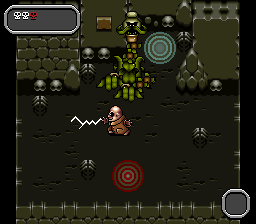
As for games people will recognize? Well, the period between the second half of January and the first half of February saw two well-known SNES puzzle games with the first Puzzle Bobble (a.k.a. Bust-A-Move) and the Mean Bean Machine-ersatz Kirby's Avalanche. There were two awful and one not-bad movie license adaptations with Addams Family Values (i.e. the good one, since it's a bit like Legend of Zelda/Zombies Ate My Neighbors with a neat graphical style), The Flintstones (they actually had a character called Sharon Stone in that movie that the real Sharon Stone refused to play) and True Lies (which, I dunno, I never really liked but it's apparently not terrible. The game I mean. The movie's great, if a bit weird in spots. "Ass like a ten-year-old boy"? What?).
Ys Origin!
I'll cap off my Ys Origin coverage by remarking on its "purity" as a dungeon crawler. Actually this is mostly a nostalgic thing: Ys Origin is, of course, heavily entrenched in the lore of the very first two games, which were released as far back as 1987. Though set centuries before Adol Christin's first foray in the Tower of Darm, Ys Origin has many, many allusions to said Tower and to Ys and the floating Solomon Shrine and the Goddesses that all play significant roles in the first two Ys games. In addition, there are four (or five, depending on the route) major characters with lore-significant surnames that choose to stay behind at the end of the game: you'll meet characters with those same surnames in the initial Ys games, with the implication that they're direct descendants. It makes sense, then, that the aspect that receives the most homage attention is the central monolithic dungeon that comprises the entirety of the game.
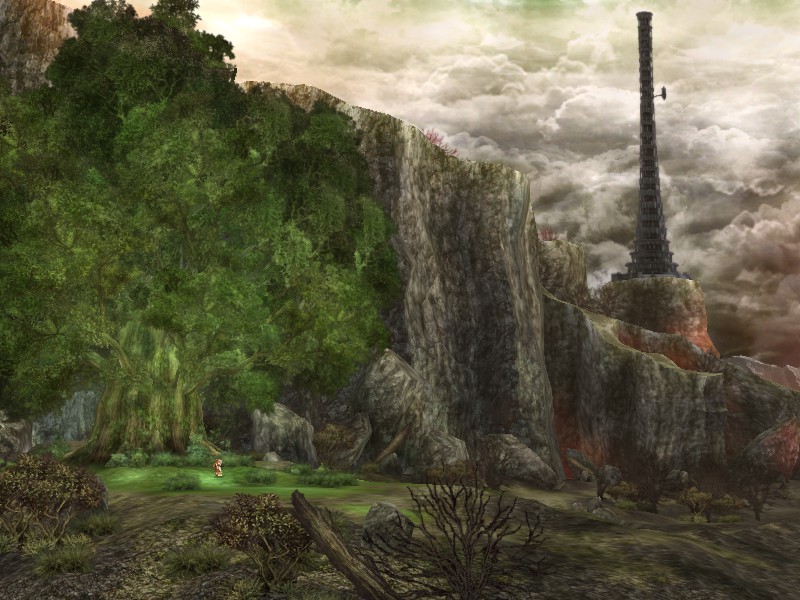
Enormous singular dungeons are nothing new in JRPGs: in fact, they were a recurring sight in the very earliest the genre had to offer, whether it was the multi-layered subterranean "proving grounds" of the first Wizardry, which would be the direct inspiration for Dragon Warrior, or the enormous towers of Ys II and Tower of Druaga. You'll see it frequently in games and external fiction that seeks to emulate an earlier period of JRPGs where there's just the one big dungeon or tower that anyone ever refers to. It's particularly common in Mystery Dungeon games and other dungeon-crawlers of a roguelike nature. Of course, you could point this out as being simply a matter of scale: these early games were limited by their size and number of moving parts, so it was natural that they would simply focus on a single dungeon. Creating multiple dungeons would also require creating means of distinguishing them, such as different graphical styles and settings or different mechanics that the player would need to learn. Consider how visually similar the nine dungeons of the original Legend of Zelda were compared to the ten of Link to the Past; all the originals had to individuate themselves with were their map layouts and the types of enemies and traps within.
We have no reason to stick to "one dungeon, one game" any more, though many choose to do so to evoke the past. When a modern game like Shin Megami Tensei: Persona 3 or Ys Origin is presenting a singular dungeon, there may be some plot significance behind that stylistic choice, but more often it's a deliberate attempt to tap into that nostalgia of gradually ascending (or descending) through an enormous dungeon that promises a momentous game-concluding event and/or encounter at its very zenith (or nadir).
Tearaway Unfolded!
All right, so it's time for some griping. Let's do the wuss thing and sandwich these complaints within a compliment sandwich:
Tearaway is adorable, though perhaps a way that tries too hard sometimes with how... wait, this is already a terrible compliment sandwich. All right, it's a good compliment sandwich, and while it could use some reworking with this opening, it has the promise of being spectacular with a little more effort. (A compliment sandwich within a compliment sandwich? What is this, the Deadpool movie?). Starting over:
Tearaway is adorable, and it has a very distinct papercraft art style that serves its core game better, at least in my view, than the round-edged quilt/needlecraft worlds of the LittleBigPlanet series, if only because slipping off those rounded edges made the platforming that much more unpleasant. Like LBP, Tearaway invites the player to join in as another member of their troupe of colorful performers, albeit one in a much more narratively authoritative role. The player, simply referred to as "the You" (also occasionally with an indefinite article, as if to suggest there are multiple Yous for the game's multiplayer features), is able to affect the world in multiple ways: the most significant is through the messenger protagonist, either referred to as Atoi or Iota depending on the gender, which the player learns to control indirectly at first and then more fully as their influence over the world grows. The only presence they have initially is via the Guiding Light of the PS4's gamepad: this works via motion control, specifically via the controller's own gyroscope than any sort of infra-red detection of the light from the TV's end. The Guiding Light has a few functions: it can be used in combat to distract enemies and to light up dark areas but also to direct the messenger and other characters as well as cause plants to bloom and corruption to vanish. The player then acquires more god-like abilities (and more things for their messenger to do, like jump and roll around as a Samus-style morph ball) as the game proceeds. It's a clever use of gradually bringing the player into the world in a meaningful way, and the game never lets up on introducing more and more gameplay aspects like those as it goes on.
However, Tearaway drops the ball a few times as a 3D platformer first and foremost. Being a genre roughly twenty years old at this point (Super Mario 64 came out in 1996. Yeah, I feel old too) it has over that time developed a certain set of guidelines and rules regarding workarounds and problem areas that 3D platformer developers learned to evolve and adhere to in order to make compelling games of that specific type. Tearaway eschews almost all of these rules, which is perhaps the source of my grievance: I can't help but feel that the game developers either didn't know what they were doing - which, as I stated in the offset, is a toxic critical attitude to maintain - or didn't consider it as significant to the core experience they were presenting as much as all of the above regarding the game's heightened sense of player agency, its distinctive papercraft visual style and the quirky and creative mechanics that said papercraft style permits.
The biggest problem of the game is its camera. Cameras have always been the bane of any 3D platformer developer given the amount of topographical and logistical issues that can arise from a wandering lens that the player is able to control to some extent. Yet, to deny the player the freedom of the camera by insisting on fixed viewpoints would make certain platforming sections considerably harder than they need to be without a camera that can be tweaked and repositioned on the go. For that reason there's only so much I can begrudge a 3D platformer for having a bad camera even after two decades of progress, but Tearaway's is especially awful to the point of being inexplicable. On occasion and for no reason, the camera will zoom in so close that you can no longer see the character's feet, making jumping puzzles as difficult as they would be with a first-person perspective. Sometimes it's so close that you cannot see your character at all, making the prospect of first-person platforming all the closer to terrifying reality. Other times it'll get stuck behind geometry or foreground details, forcing the player to spend a few moments trying to knock it out of whatever tree it's caught up in like an errant kite. There aren't any camera controls for the game, beyond the standard circular movement around the character with the left analog stick, so you're largely stuck with whatever disastrously close or obfuscated perspective the game chooses to present at any given moment.
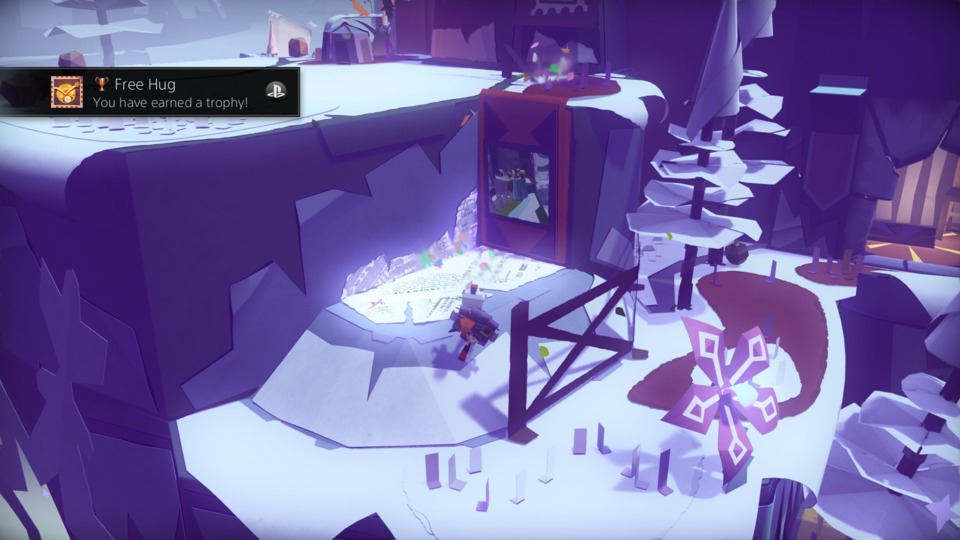
The game is also a nightmare for fans of collect-a-thons, which I would imagine is a significant portion of 3D platformer enthusiasts who first cut their teeth on the N64 platformers put out by Rare. It will regularly block off previous areas, usually for no other reason than to keep you moving to the next idiosyncratic puzzle or cutscene, and each of the game's large linear levels take roughly 30-45 minutes to complete, though considerably less if you're speedrunning through them. Keep in mind as I elaborate on the game's collectibles now that there's usually no way to return to previous areas once a new checkpoint has been reached: the only reliable way is to restart the entire level from the very beginning, and the game only lets you skip so much of its introductory cutscenes and tutorials every time you do this.
There's a plethora of collectible types to find on every stage, suggesting that the Tearaway people were fairly conscious about this aspect of 3D platforming:
- Confetti is the game's de facto currency for its papercraft and camera upgrades (all cosmetic and inessential for the main progression) and there's usually several hundred per level, so if you're short two or three of them by the end that's, well, going to be hard to fix. At least they stand out against the background, though they're frequently hidden inside secret areas and the like and those are more likely to be the ones you're missing.
- The next collectible type are the red presents. Red presents are far better hidden and reward a lot of confetti as a result; they usually require that you solve a jumping puzzle in such an odd way that it opens a little side-area, or placed behind or underneath parts of the landscape. The game elects to not give you any kind of visual indication of which presents you have found, say in a sequence of grayed out and filled-in icons, so if you're missing one it could literally be anywhere in the level.
- Papercraft plans are found by taking a picture of an NPC or object that is completely devoid of color: the sheer white models stand out against the otherwise colorful backgrounds, excepting of course for the game's handful of levels that are also snowy or stark white, and like the red presents there's no obvious indication of which ones you're missing. The game does keep track of the ones you've found in a papercraft album - the idea being that you download the schematics for these objects so you can make them at home origami-style - but the order they appear in the album is not the same as the order they are found in the levels. For some reason.
- Another collectible are the enemies themselves, referred to as Scraps. Scraps come in all shapes and sizes (well, they're all universally cuboid, so let's just say "all sizes") and require different strategies to defeat depending on their type. The first odd thing about this collectible is that you're nearly always forced to fight and defeat a group of Scraps in little arena battles in order to progress, which makes it perplexing when you end a stage and notice you still have a few missing from the total. The second odd thing is that the Scraps always repopulate whenever you replay a level, so there's no way of determining which ones are the Scraps that you missed the first time through: you simply have to defeat them all again and hope they didn't somehow land safely outside the playing field, such as behind a wall or object.
- Blue presents are rewarded for little bonus missions, usually given by NPCs as requests to take a picture of a certain thing or to create new facial features or decorations. These missions always feel a bit like Drawn to Life or Graffiti Kingdom; little moments to let the player have some fun with their imaginations and artistic talents, for as meager as they might be (in my case especially).
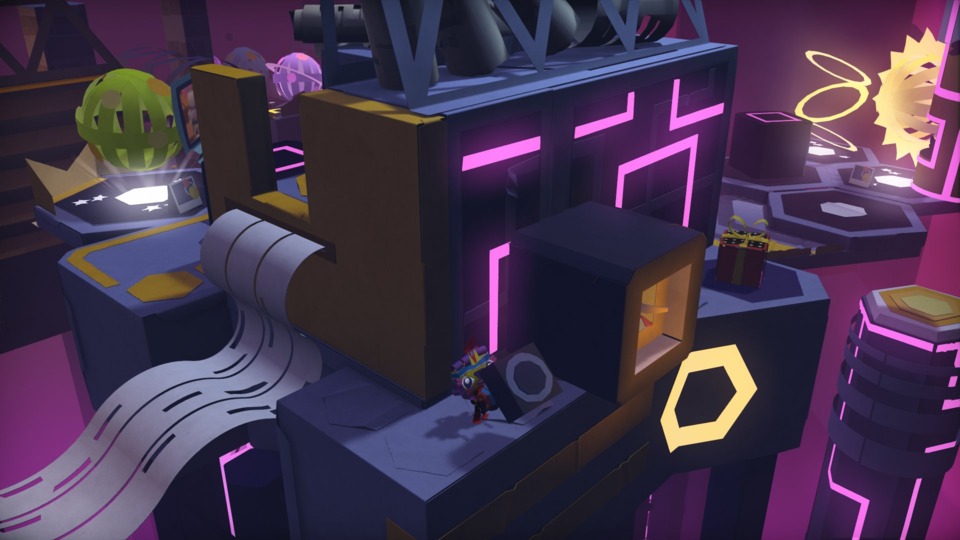
There is one exception to these artsy-craftsy side-activities, which is a recurring side-mission for many stages: the Misplaced Gopher. The player can decorate and name this little guy (or gal) the first time they meet them, and the idea is to get them to their home much later in the same level. That means picking them up, carrying them through a bunch of Scrap fights, jumping sequences and other obstacles and never letting them get out of sight, or accidentally tossed from the level. The player is also prohibited from losing a life: if this happens, MG panics and bails on you, vanishing for good.
The Misplaced Gopher missions are the worst things ever created by a human.
It is so easy to miss a jump (some of LGP's floaty jump physics still apply) or simply walk off the world because the eccentric art style can create some visual confusion. As with the TT LEGO games, there's a vast number of occasions where the player might temporarily die via a simple misstep or moment of carelessness, and both they and Tearaway mitigate this by instantly respawning you nearby no worse for the wear. The only time when Aoti/Iota's brief demise has any impact on the game is during these MG missions, which are necessary for 100% completion of any given stage.
So remember early on when I said you couldn't revisit earlier parts of a level without restarting from the beginning? Yeah. These missions are absolute torture for anyone hoping to get 100%, and I must insist that you give this game a wide berth if you're one to compulsively reach for total completion in 3D platformers like Tearaway. They have no reason to be this unpleasant either, is perhaps the most disconcerting thing: the stages could've been more open to allow the player to backtrack to the gopher's origin point and start the side-mission over if they so wished; the game could've allowed the gopher to remain on-screen as long as the gopher itself was safe even if the messenger dies; or the game could've chosen to construct these missions another way, perhaps one where you use your Guiding Light to maneuver the little guy back to his hut through a field of gopher-sized obstacles. Hell, it'd be nice if certain enemies didn't sprint for the gopher and throw it off the level the first chance they got. Tearaway could've, at the very least, given you the option to warp to any checkpoint, perhaps only after you'd beaten the stage once for the sake of fairness. It boggles the mind that a game can progress so far through development without anyone picking up on this, but now I'm getting too backseat designer again. You understand what I mean about a bad experience bringing out the worst in a critic, I hope.
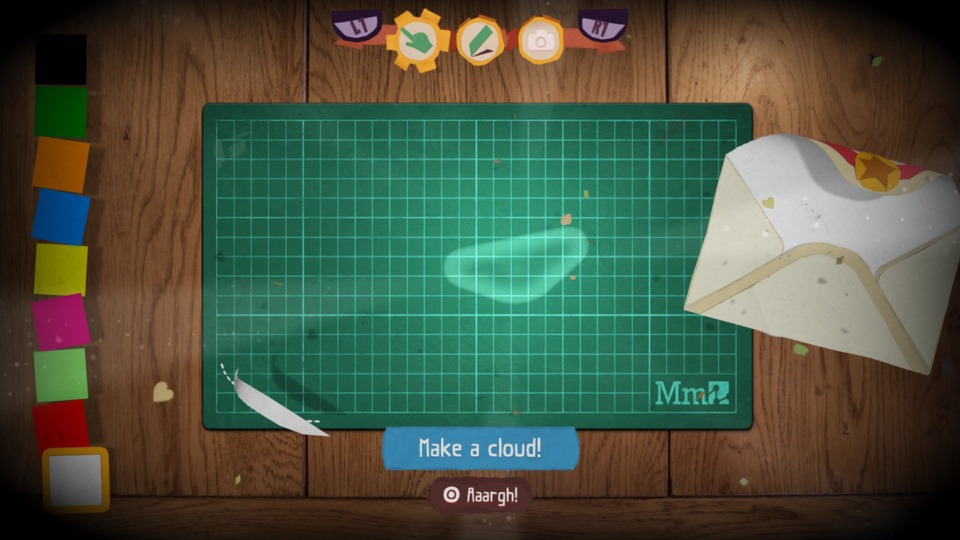
Tearaway isn't a bad game. I'd put it on a short list of games that would be entirely acceptable if you aren't aiming for 100% completion, because for every misstep it takes with its bad camera or lack of fluid controls it presents something delightfully creative through its gameplay mechanics: whether that's a player-controlled gust of wind that causes flaps of paper to become bridges or doors to new areas, or a paper plane that uses those same gusts of winds to fly the messenger to new lands, or a cute companion that the player has to cooperate with for a few areas by throwing items back and forth, or some dramatic tonal shifts as they move through scary regions filled with (still somehow adorable) monsters, or how you might be in a quaint sea port one moment and a futuristic lab looking into the purpose of "buttons" and the theoretical existence of the player the next. The game's full of surprises, and I actually like the narrative and how its presented by two bickering deities who have different ideas about what constitutes a good story that the player might enjoy. There's enough to keep me going, but I'm having to put a lot of troubling aspects aside in order to enjoy the game for what it is. More than I usually have to overlook, if the verbose venting above is any indication.
I'll have a more to say on Tearaway next week, I'm sure, but let's cut off this edition of Sunday Summaries while we're ahead. Thanks for stopping by, and for the next Sunday Summaries I hope to start throwing in more small Steam indies so as to evenly distribute my vitriol. By which I of course mean "fair and considered constructive criticism". See you then.
